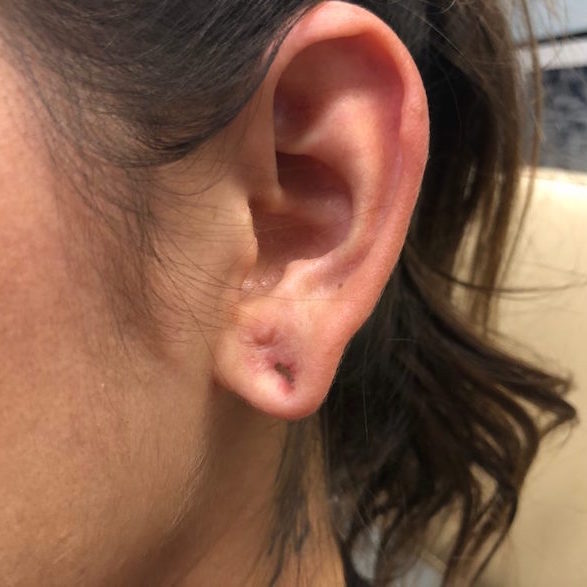
Snatching Edges: The Earlobe Kind
If you’re anything like us, you probably got your ears pierced as a kid… and again as a teen. But if you wore weighty dangling earrings day in and day out for years on end (or went through an edgy phase and got gauges) you may be dealing with torn and/or stretched earlobes as an adult.…
Published:
3 minute read
If you’re anything like us, you probably got your ears pierced as a kid… and again as a teen. But if you wore weighty dangling earrings day in and day out for years on end (or went through an edgy phase and got gauges) you may be dealing with torn and/or stretched earlobes as an adult. Not only is having stretched lobes less than ideal look wise, it also makes putting anything into your lobes impossible. Want to be able to wear earrings once again? There’s a way! Read on to find out if an ear repair surgery is right for you.

First things first: What causes earlobes to tear or stretch?
Unlike other parts of your ear, your lobe doesn’t have any bone or cartilage — it’s made entirely of skin and fat. That makes it way more susceptible to tearing. Constantly wearing heavy earrings, getting a piercing too close to the edge of your lobe, or trauma (say, a baby tugging and pulling at your earring) can all cause tears. Sometimes, these tears go all the way down to the bottom of your lobe, splitting it in two.
Meanwhile, stretching is most often caused intentionally by wearing gauges (we know, this was totally cool when you were younger). Either way, putting on a pair of studs is a no-go if your earlobes are torn or stretched. But, like we said, you might be a candidate for ear repair surgery if this sounds like what’s happened to your ears.
How does ear repair surgery work?
Ear repair surgery is a relatively minimal procedure that should only be slightly uncomfortable. It’s done in a dermatologist’s practice or plastic surgeon’s office and you can go home immediately.
To start, your doctor will inject your earlobe with a numbing anesthetic. Then, they’ll cut out the skin around your tear, remove any tissue that has stretched, and sew your earlobe back up with tiny stitches. This process can take anywhere from 15 minutes to an hour, depending on the severity of your tear.
Dr. Sandra Lee (who you might know as Dr. Pimple Popper) frequently performs ear repair surgeries — and really enjoys doing the procedure!
“I love these types of surgeries because they’re like this fun puzzle, where you have to look at the person’s ears to really figure out how to properly make incisions and cuts to get their ear lobe back to a perfect state,” explains Dr. Lee. “I love that kind of challenge, and I love how happy people are to get their regular, not stretched earlobes back!!”
Below is Noelle, one of the patients that Dr. Lee helped on her TLC reality show, right after her ear repair surgery!

What’s the recovery process like?
We have good news — there’s really no downtime. You can go about your day as soon as the surgery is over! That being said, you might experience mild pain immediately afterward, but OTC meds (like ibuprofen) can help alleviate your discomfort. For the first day post-surgery, you’ll have to keep your ear covered in gauze. After the first day, you should clean your lobes and apply an antibiotic ointment every day to prevent infection — and you’ll need to visit your doctor a week later to have your stitches removed. Until you have your stitches removed, don’t sleep on your ear or place too much pressure on it, either. You may notice a teeny bright red scar on your earlobes once your stitches have been taken out but, over time, that will heal.
Can I get my ears pierced again?
Depending on your situation, it might be possible for you to get your ears pierced during the surgical process. However, it’s often recommended that you wait at least four to six weeks before having your ears pierced again so your ears have time to heal before going near a piercing gun or needle. Keep in mind that your new holes won’t be placed in the same exact spot as the old ones — this way you don’t risk tearing your lobes again.
How can I prevent earlobe tears in the future?
We know big hoops and dangling earrings are in, but moving forward, they’re not the best options if you’re trying to avoid tears in the future. Rock a cute pair of lightweight studs instead! Rock a cute pair of lightweight studs instead — and enjoy showing off your lobes once again!
Dr. Ashley Steffens, a dermatology resident at Southern Illinois University School of Medicine (SIU), helped contribute to the accuracy of this story.






